If you’re one of those people who has a must-see creatures list, you need to update it stat! Here are some of the most popular Marine Life in the Philippines you must see for yourself.
When it comes to marine life, the Philippines has one of the most diverse in the region. Located in the “Coral Triangle”, The Philippines sits in the epicenter for the biodiversity of corals, fish, and other marine life in the world.
There are over 488 species of corals, 981 species of bottom-living algae, 5000 species of clams, snails, and mollusks that can be found in its waters. On top of that, over 3000 fish species have been recorded to be endemic to the Philippines.
The list of marine life in the Philippines keeps growing as more species are being discovered.
With such diversity, it is not surprising that the Philippines is considered to be one of the top scuba diving destinations in the world.
The marine life in the Philippines is astounding. Underwater photographers in particular love diving in the Philippines because of the amazing sea creatures one can find in its waters.
While there is “plenty of fish” in the Philippine sea, some sea creatures are more favored than others. They stand out because of their colors, behavior, distinct characteristics, rareness, and just plain awesomeness. Some are even more special than others that divers are even willing to travel hundreds of miles just to see them.
From large marine animals to small ocean critters, there’s always something new and interesting to see while diving in the Philippines.
Want to know what sea creatures in the Philippines do scuba divers have on their “Must-see Critters List”? Or do you need help with your fish identification? This article has a list of fish in the Philippines as well as marine invertebrates!
Here are 100 of the most popular marine life in the Philippines.
Editor’s Note: All photos below were photographed from all my dives. It is my personal goal to see all 100 on the list, so I apologize if there are some that have no photos yet. I will update them in the future once I’ve seen them.
Saltwater Reef Fishes in the Philippines (27)
False Clown Anemonefish (Amphiprion ocellaris)
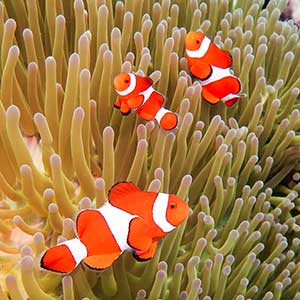
This orange fish with white band outlined in black is one of the most popular fish in the ocean. You may know this one as “Nemo!” While anemonefish are very common to find in the Philippines, this Hollywood star can easily be the star in your dive. If you’re lucky you might even find a nest with hundreds of baby Nemos.
Pinnate Spadefish (Platax pinnatus)
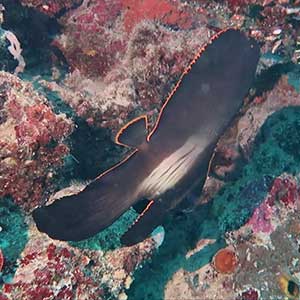
This is one of those species that undergoes a distinct transformation from its juvenile state to its maturity. As juveniles, the pinnate spadefish are completely black with an orange band running around the outline of its body. Then as adults, they become silver-colored, spade-shaped fish. It is a beautiful species in either form and a favorite subject by underwater photographers.
Bluetail unicornfish (Naso caeruleacauda)
Don’t believe in unicorns? Well, they do exist underwater! These fishes are hard to miss because of the distinct bony horn projecting from the head in front of the eyes. They’re said to be tasty so you might find local Filipinos grilling them for lunch.
Barramundi Grouper (Cromileptes altivelis)
Also known as “barramundi cod,” “flatfish grouper” and “humpback rockcod,” humpback groupers have very small, pointed heads and are light-colored with scattered, large, black spots. They’re listed as “vulnerable” in the IUCN list as they are targeted for live reef-fish trade. Unfortunately, if you do find one, it might be in the wet market or in some restaurant.
Bumphead Parrotfish (Bolbometopon muricatum)
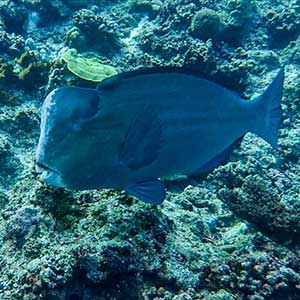
The bumphead parrotfish, also known as humphead parrotfish, is the biggest parrotfish in the ocean. Their size and the distinct “bump on their head” make them stand out.
Pajama Cardinalfish (Sphaeramia nematoptera)
When you see these colorful fishes, you will understand why it was named as such. Their vibrant and distinct markings make them popular among divers. These sea animals found in the Philippines do appear like they are wearing pajamas. And it’s for this reason that they are popular among aquarium hobbyists as well.
Mandarinfish (Synchiropus splendidus)
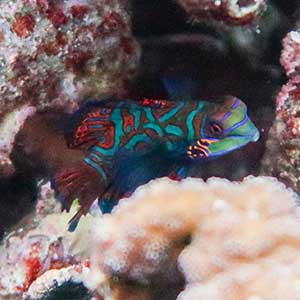
This dragonet has attractive blue, green, and orange wavy patterns on its tiny body, that catches the attention of many divers. But what makes them even more popular is the mandarin fish mating ritual dance which you can watch during a dusk dive in places like Moalboal, Malapascua, Southern Leyte.
Yellowbarred Jawfish (Opistognathus randalli)
Normally found with their heads poking out of sandy burrows, jawfish have huge mouths for the size of their head. Which probably explains their name. But what makes them even more popular is that the males are mouthbrooders. This means that the males incubate the eggs in their mouths for five to seven days until their babies are fully developed.
Magnificent Shrimp Goby (Tomiyamichthys emilyae)
The magnificent shrimp gobies are popular because of their large and beautiful first dorsal fin. They’re often found with their burrow partners, Randall’s pistol shrimp. This unique goby and shrimp pairing make them even more interesting underwater subjects to observe and photograph.
Oriental flying gurnard (Dactyloptena orientalis)
Oriental flying gurnard, also known as flying fish, grunt fish or sea robin, are reef fish that has large pectoral fins that look like wings. Their fins are usually against their body but when they threatened they expand their pectoral fins to scare of predators. They have been observed “walking” on the ocean floor using their pelvic fins. And they also “grunt” thus the name gurnard which means to grunt in French.
Frogfish
Frogfishes are among the most popular marine life in the Philippines. These weird-looking but wonderful creatures are great in hiding or blending in with the reef that when divers spot them its always a delight.
While they can be found almost everywhere, if you want higher chances of seeing them then Dauin is the place to go. It has been called the “frogfish capital of the world” with 11 frogfishes species being spotted in the area.
Here are some of the frogfish species that can be found in the Philippines:
Giant Frogfish (Antennarius commerson)
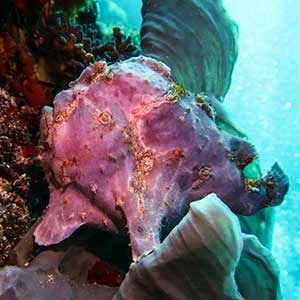
Giant frogfish are have excellent camouflage skills. They have the ability to change colour over time to match their surroundings. You will often find them looking like a sponge, coral or rock.
Warty/ Clown Frogfish (Antennarius maculatus)
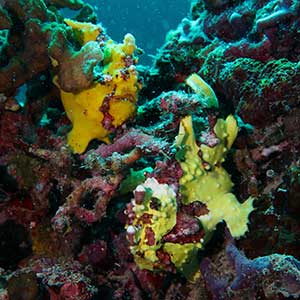
The Warty frogfish also known as the clown frogfish is one of the more colorful frogfishes. They get its name from the wart-like protrusions on its body.
Painted/ Spotted Frogfish (Antennarius pictus)
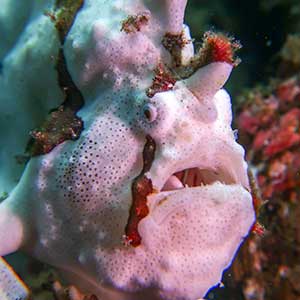
The painted frogfish, also known as the spotted frogfish, is one of the more bigger frogfish growing up to 30 centimeter (1 feet). They get its name from the empty “spots,” that looks like enlarged pores, on its body.
Hairy Frogfish (Antennarius striatus)
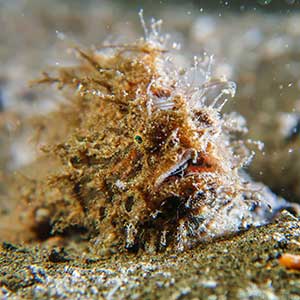
The hairy frogfish is not actually hairy. Their body is actually covered in spinules or skin appendages that look like strands of hair.
If you love frogfishes, you might also want to check out the PADI Frogfish Specialist course that is exclusively offered in Dauin.
Napoleon Wrasse (Cheilinus undulatus)
The Napoleon wrasse (Cheilinus undulatus), also known as the Māori wrasse, hump head wrasse, get its name from the distinctive hump on its forehead, which resembles the hat of the French emperor Napoleon Bonaparte. Napoleon wrasses are known to grow up to 2 meters long (6feet) and have beautiful green scales. They are popular marine life in the Philippines not just under the sea but also in dinner tables. Locally called “Mameng”, wrasses are also endangered species in the Philippines because of overfishing for their meat.
Weedy Scorpionfish (Rhinopias frondosa)
While scorpionfishes are very common to see in the Philippines. The weedy scorpionfish (Rhinopias frondosa) are a bit more rare to come by. Or at least harder to spot.
These marine life in the Philippines are masters of disguise. The weedy scorpionfish looks like rocks covered in algae. Their appendages look like they are covered in weed so they easily blend in. Rhinopias come in dark red, purple, yellow or lavender, making them appear like soft corals or sponges to an untrained eye.
Red Lionfish (Pterois volitans)
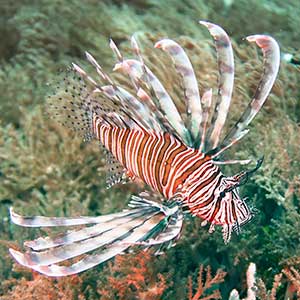
Red Lionfishes are commonly found in the Philippine. They’re very pretty to look at especially when they spread out their spines. But you should keep your distance as they are venomous. While they are endemic in the Indo-pacific area they are considered invasive species in the Carribean and Atlantic regions. Lionfishes are popular in the aquarium trade and this may have caused the spread of this invasive species in other reefs in the world.
Crocodile Flathead (Cymbacephalus beauforti)
The Crocodile Flathead is closely related to scorpionfishes. As their names suggest they menacingly look like crocodiles! Their body is covered in mosaic patterns of beige, brown, green, gray, which helps them blend in their habitat. They’re commonly found resting on rubble or sand.
Whitemargin stargazer (Uranoscopus sulphureus)
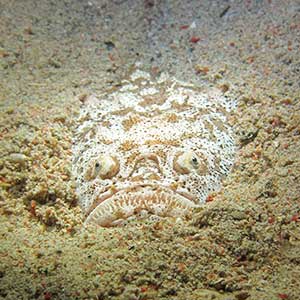
Stargazers are bottom-dwelling predators often found burrowing in the sand with only their eyes protruding. So they do look like they are always gazing at the stars. Their mouths are almost at the same level as their eyes so when an unsuspecting creature swims over them they could easily be devoured.
Yellow Boxfish (Ostracion cubicus)
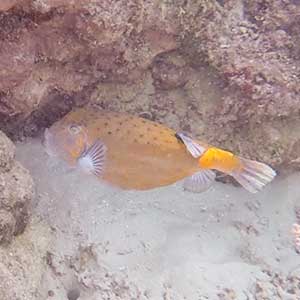
The Ostracion cubicus easily stands out in the reef because of its box-shaped body and yellow coloration. The yellow boxfish at its juvenile stage is bright yellow with black spots. As it matures, its color becomes light yellow with blue-gray colorations.
Striped Eel Catfish (Plotosus lineatus)
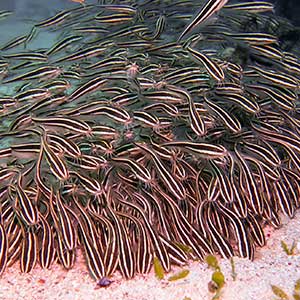
The striped eel catfish often catches a diver’s attention because of their black and white stripes and their schooling behavior as juveniles. To protect themselves from predators, they form a cluster of of up to a hundred catfishes. But don’t let these seemingly harmless fishes fool you, their dorsal and pectoral fin spines are actually highly venomous and can inflict you pain.
Titan Triggerfish (Balistoides viridescens)
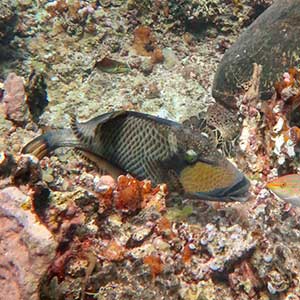
The Titan Triggerfish, also known as Moustache or Giant Triggerfish, is the largest and most aggressive of the Triggerfish. They are notorious among divers because they’re known to attack especially when it is their nesting season. Best to stay clear of these creatures as there probably have been more cases of Titan triggerfish bites than shark attack!
Spot-fin Porcupinefish (Diodon hystrix)
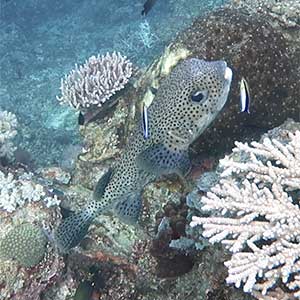
The spot-fin porcupinefish is a kind of pufferfish with spines. Its body coloration is beige marbled with dark blotches and dotted with numerous black spots. When it senses danger or when it is stressed, the porcupinefish can inflate itself by swallowing water. It will “puff up” into a balloon with its spines raised to prevent predators from consuming it. The pufferfish has poison that if consumed can kill humans. This, however, does not deter them from eating it. In fact, some catch it as they are considered delicacies.
Ocean Sunfish (Mola mola)
The Mola mola is one of the heaviest known bony fishes in the world. The Ocean Sunfish got its name from its behavior of going to the surface then swimming on its side to bask in the sun. Many provinces in the Philippines have reported Mola mola sighting and stranding which is why it’s made it to this list of popular marine life in the Philippines.
Big Eye Trevally (Caranx Sexfasciatus)
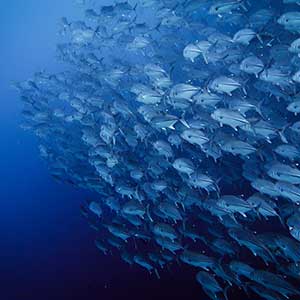
The Big Eye Trevally (Caranx Sexfasciatus) is truly a sight to behold when these silvery fishes start swimming in a circle creating a giant bait ball. Make sure to keep your “big eyes” out for these school of jacks. They can be spotted in Balicasag Island.
Blackfin Barracuda (Sphyraena qenie)
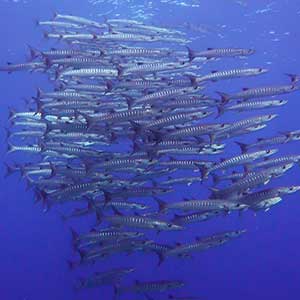
While the Great Barracuda (Sphyraena barracuda) tends to be a solitary creature, the blackfin barracuda is usually seen as a group. They’re also known as chevron barracuda because of their black markings along its body. Aside from their distinct markings and schooling behavior, they’re known for their speed and razor sharp teeth.
School of Sardines
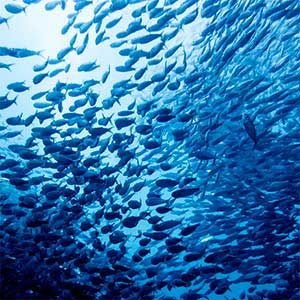
The Sardines Run in Moalboal is one of the most epic experiences you can have while diving in the Philippines. It’s not every day you get to dive with millions of sardines. This is not an exaggeration.
Read More: 15 Dangerous Sea Creatures in the Philippines
Eels (3)
Giant Moray Eel (Gymnothorax javanicus)
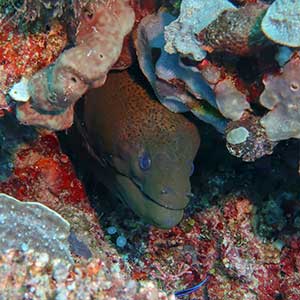
The giant moray eel as its name suggests, is the largest eel in the ocean reaching up to 3 meters (9.8 feet)! It is brownish in color with leopard-like spots on its head.
Ribbon Eels (Rhinomuraena quaesita)
The ribbon eel is easily recognized because of its vibrant yellow and blue color. Its long and thin body and distinct anterior nostrils often remind divers of the mythical Chinese dragon.
Spotted Garden Eel (Heteroconger hassi)
Gardens eels are extremely shy eels that love burrowing themselves on the ocean floor. You can find groups of them coming out of the sand as they feed on plankton. From a distance they look like sea grass swaying in the current but if you approach they will retract and go back into hiding.
Seahorse and Pipefish (6)
Here are some of the most requested seahorses and pipefishes species divers want to see while scuba diving in the Philippines.
Robust Ghost Pipefish (Solenostomus cyanopterus)
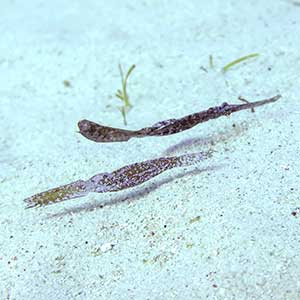
The Robust Ghost Pipefish gets its name of ghost from the difficulty in seeing them when they are floating around. They’re often seen swimming in pairs on a sandy bottom. It is very common for divers to not notice them as they closely resemble pieces of seaweed just floating around.
Ornate Ghost pipefish (Solenostomus paradoxus)
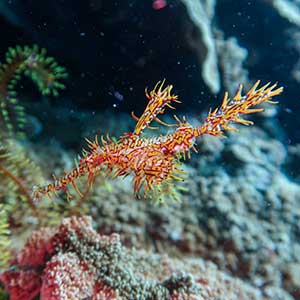
The Ornate Ghost Pipefish, also known as the Harlequin Ghost Pipefish, is a close relative of pipefishes and seahorses. They have intricate patterns on their body in color variations of red, black or yellow, thus, the name “ornate”. You can usually find them in pairs hiding in feather stars or soft coral species that allows them to camouflage.
Thorny Seahorse (Hippocampus histrix)
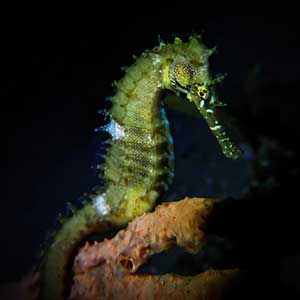
The thorny seahorse is one of the eleven seahorse species you can find in the Philippines. They are often found singly or in pairs with their tails wrapped around algae, sponges, rocky reefs, soft corals or sea grass. Under CITES for Appendix II extraction and export of seahorses (Hippocampus spp.) are illegal since 2004. But this has not stopped the Philippines as one of the major exporters of seahorses. Dried seahorse is used as Chinese medicine.
Pygmy Seahorse
Pygmy seahorses are tiny fish that grow to an average size of 1.4 to 2.7 cm (0.55 to 1.06 inches) often found in sea fans. To date, there are eight pygmy seahorse species all over the world, three of which have been spotted in the Philippines.
Bargibanti Pygmy Seahorse (Hippocampus bargibanti)
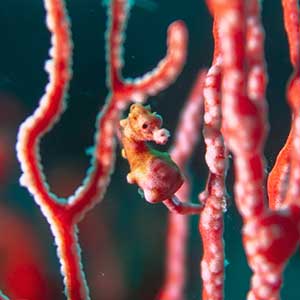
They are experts at hiding that they were only discovered in 1969 by George Bargibant who was studying gorgonians. Bargibanti pygmy seahorse was the first pygmy to be discovered.
Denise Pygmy Seahorse (Hippocampus denise)
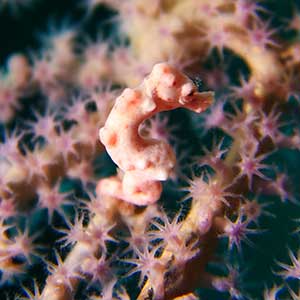
Denise pygmy seahorse, also known as the yellow pygmy seahorse, has a short snout with slender body. They are usually yellow to orange in color and they change their coloration to match the gorgonian they live in.
Pontohi Pygmy Seahorse (Hippocampus pontohi)
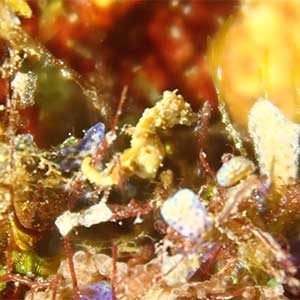
Pontohi pygmy seahorse, also known as the weedy seahorse, was named after Hence Pontoh, and Indonesian dive guide who first brought these pygmy seahorses to attention. The previously known Severn Pygmy (Hippocampus severnsi), was recently synonymized with the Pontohi. They are the same size, but Severn is brown in color, while Pontohi is more lighter. You can find this species in Romblon.
Rays and Sharks in the Philippines (8)
Here are some rays and shark species you must- see while diving in the Philippines.
Giant Oceanic Manta (Manta birostris)
The giant oceanic manta is one of the marine life you can occasionally encounter in the Philippines. If you want to encounter one or more, you will have bigger chance of seeing them in Ticao Pass. This area in Donsol has a high concentration of planktons and strong currents which the mantas love. The manta rays flock to the “manta bowl” as this serves as their cleaning stations.
Ocellated Eagle Ray (Aetobatus ocellatus)
The spotted eagle ray has flat diamond-shaped bodies with a distinctive snout similar to a duck’s bill. They are often colored black with white spots on top with a white underbelly. Their tails have venomous spines. Eagle rays may grow up to 5 meters (16.4 feet) from head to tail, and their wingspans may extend up to 3 meters (9.8 feet)
Blue-spotted Ribbontail Ray (Taeniura lymma)
The blue-spotted ribbon tail ray is a smaller oval-bodied ray that grows to about 30 cm (1 feet) in diameter. Its coloration varies from brown to yellow to olive-green with lots of bright blue spots. Its tail has two blue stripes along its length and two venomous spines. These shy creatures are often found in sandy substrates. They tend to swim away when scuba divers approach.
Confused about these different rays?
Read my post on Manta rays vs Stingrays to learn about their differences.
Whale Shark (Rhincodon typus)
Whale sharks are the largest fish in the world. And the Philippines officially hosts the second-largest known population of whale sharks in the world. If you’ve been dreaming of swimming with whale sharks, you can visit Donsol, Oslob, Sogod Bay, Tubbataha as these are known hotspots for the gentle giants.
Love whale sharks? Check out my post on the best whale shark gifts!
Thresher Shark (Alopias Pelagicus)
This particular marine life in the Philippines is known for its their scythe-like tail fins. If you’ve been wanting to see thresher sharks, Malapascua Island in Cebu, is the best place to see them. As pelagic creatures, they’re usually seen purely by chance, but in Monad Shoal divers can see them almost every day.
Tiger Sharks (Galeocerdo cuvier)
Tiger sharks are highly aggressive sharks that can grow up to 5 meters. It gets its name from the dark stripes similarly found on a tiger’s body. As pelagic creatures tiger sharks are rarely found in the Philippines. However, many divers have successfully spotted them in one of the most successful and largest marine protected areas in the Philippines- Tubbataha Reefs Natural Park.
Philippine Guitarfish (Rhinobatos whitei)
If a shark and a ray had a baby it would probably look like a guitarfish! Also called a banjo shark or fiddler ray, guitarfish have a flattened fore-body resembling that of a ray and a hind-body resembling that of a shark. In 2014, the Philippine Guitarfish Rhinobatos white, an endemic marine species in the Philippines, was recognized as a new species belonging to the Rhinobatidae family.
Scalloped hammerhead (Sphyrna lewini)
While hammerhead sharks have been spotted in the Philippines, in recent years sightings has been more rare. Unfortunately, despite Philippine laws prohibiting the capture of these endangered species, there might even be a greater chance of you seeing hammerheads in the wet market than in the ocean. In the past scalloped hammerhead sharks have been seen in places like Malapascua in Cebu, Cabilao in Bohol, Apo Reef in Mindoro and Tubbataha Reef in Sulu Sea.
Love sharks? Check out my post on the best shark-themed gifts!
Learn more about sharks by reading these 35 Fun Facts About Sharks.
Do you need help identifying some of the marine life in the Philippines? Check out these helpful Fish ID books!
Sea Turtles in the Philippines (5)
The Sea turtle, locally known as the Pawikan is one of the most popular marine life in the Philippines. They’re so popular that they are classified as critically endangered marine animals in the Philipines. This is due to various human threats like plastic pollution, illegal poaching, and degradation of their natural habitats. There are seven species of sea turtles and five of them can be found in the Philippines.
Green Sea Turtle (Chelonia mydas)
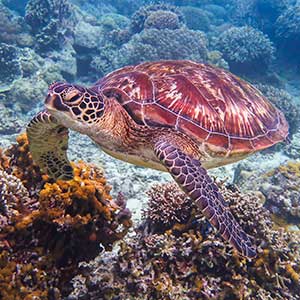
Named for the green color of the fat under its shell, the green sea turtle is strictly herbivorous as an adult. They love eating algae and sea grass.
Olive Ridley Sea Turtle (Lepidochelys olivacea)
Named for its olive green-colored shell, olive ridley sea turtle species is the second smallest and most abundant of all sea turtles found in the world.
Hawksbill Sea Turtle (Eretmochelys imbricata)
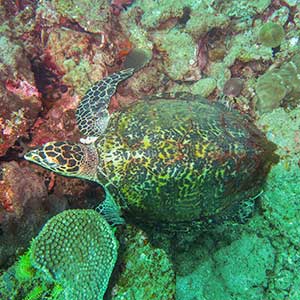
Named for its narrow head and hawk-like beak, the hawksbill sea turtles are critically endangered because of humans hunting them for their prized “tortoise shell.”
Leatherback Sea Turtle (Dermochelys coriacea)
Named for its unique shell which is composed of a layer of thin, tough, rubbery skin strengthened by thousands of tiny bone plates that makes it look leathery, the leatherback sea turtle is the only sea turtle that lacks a hard shell.
Loggerhead Sea Turtle (Caretta caretta)
Named for its exceptionally large head, loggerhead sea turtles are the largest of all hard-shelled turtles.
Want to swim with sea turtles? Here are 6 of the Best Places to Swim with Sea Turtles in the Philippines.
You might also want to check out my list of best sea turtle gifts!
Marine Mammals in the Philippines (3)
Marine mammals in the Philippines are classified into cetaceans (whales, dolphins, and porpoises) and sirenians (manatees and dugongs). Here are some of the most popular marine mammals in the Philippines.
Sea Cow Dugong (Dugong dugon)
The dugongs, also known as sea cows or sea pigs, are critically endangered mammals in the Philippines. Historically, it is estimated that almost every island in the Philippines had dugongs. However, they disappeared with the loss of sea grass, the sea cow’s favorite meal. Nowadays, you can go diving to search for dugongs in Palawan.
Where to Scuba Dive with Dugongs in the Philippines
Spinner Dolphin (Stenella longirostris)
In the Philippines, the spinner dolphins are among the most commonly sighted dolphin species across the archipelago. They’re very social and like putting on a show. They often swimming as a pod with other species and they are often seen frolicking in the surface to the delight of many dolphin watchers.
Dolphin Watching Destinations in the Philippines
Humpback Whale (Megaptera novaeangliae)
Humpback whales are migratory mammals that feed near the poles during the summer and breed in warmer waters in the equator during the winter. In the northern part of the Philippines, specifically in Babuyan islands, Humpback whales are frequently spotted as this is part of their migration route.
Echinoderms (6)
Echinoderms are marine invertebrates characterized by a hard, spiny covering or skin. Sea stars, sea urchins and sea cucumbers are echinoderms. Here are some species endemic to the Philippines.
Saw-tooth Feather Stars (Oligometra serripinna)
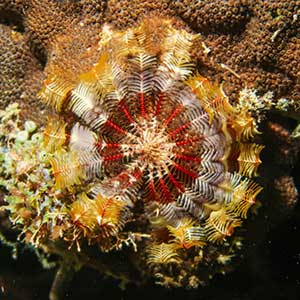
The Saw-tooth feather stars are marine invertebrates that have ten long and slender, feather-like arms. They are use their arms to catch food as well as for crawling on the reef or swimming in midwater.
Chocolate Chip Starfish (Protoreaster nodosus)
The Chocolate Chip starfish is named as such because of the small black horns on its body that look like chocolate chips. These sea stars are usually red or brown in coloration.
Crown of Thorns Starfish (Acanthaster planci)
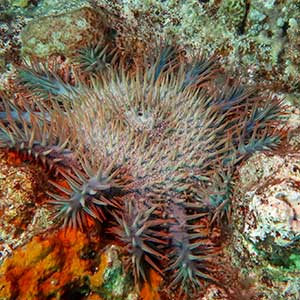
The Crown of Thorns Starfish (COTS) are large dark green starfish with up to 23 arms. Along its arms are sharp spines containing venom. COTs preys on corals. And its primary predator is the giant triton (Charonia tritonis). The lack of predators can create a COTs outbreak which is bad for the reef. Acanthaster planci can consume large areas of corals in a matter of weeks.
Yellow Sea Cucumbers (Colochirus robustus)
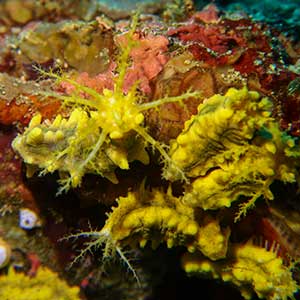
The yellow sea cucumbers, also known as robust sea cucumber, are small yellow sea cucumbers that grow up to 7 centimetres (2.8 in). Their tiny size can sometime make them be mistaken as sea slugs. These sea cucumbers are also popular in the aquarium, as well as food trade.
Fire Urchins (Astropyga radiata)
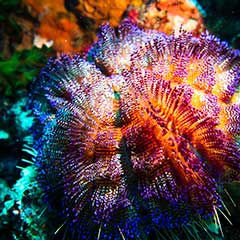
The fire urchin is a large urchin with a diameter of up to 20 cm (8 in). It has spines that are 4 cm (1.6 in) long, grouped in five vertical clusters. In between each cluster are V-shaped areas with no spines. These bare areas are red with lines of iridescent blue dots while the colour of the rest of the spines varies from reddish brown to purple, dark brown or nearly black.
Flower Urchins (Toxopneustes pileolus)
Flower urchins have pincer-like organs called pedicellariae which they use for defense and debris removal. The Pedicellariae on the Toxopneustes pileolus are white with pink centers that look like tiny flowers. Don’t let these pretty urchin fool you as they are extremely venomous marine life in the Philippines.
Shelled Molluscs (3)
You can find many mollusks in the Philippines. Here are more fascinating marine life in the Philippines.
True Giant Clams (Tridacna gigas)
The Tridacna giga is the largest living marine bivalves that can be found in the Philippines. Giant clams may reach up to 1.5 meters (6 feet) in length. and can weight up to 200 kilos (440 pounds). They are classified as endangered species in the Philippines as they are exploited for their meat and shells.
Electric Clams (Ctenoides ales)
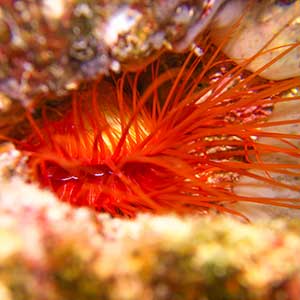
Electric clams, also known as electric flame scallop or disco clams, are bivalves that have a highly reflective tissue on the outer edge of their mantle. When sunlight or light hits the tissue, it looks like electricity is running through the clam. But what you are seeing is actually a light reflection.
Tiger Cowrie (Cypraea tigris)
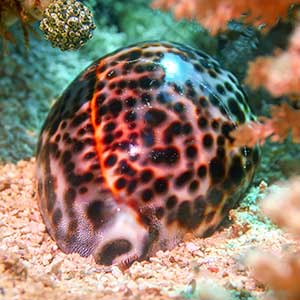
Cypraea tigris relates to its common name “tiger,” though spotted and not stripped. Tiger Cowries are nocturnal creatures so during the day their mantle is retracted for protection. It’s beautiful shell is popular among shell collectors.
Slugs and Nudibranchs in the Philippines (9)
Sea slugs and nudibranchs are one of the most popular marine life in the Philippines. Their tiny size, color and slow movements make them the perfect underwater photography subjects.
Nudibranchs, which means ‘naked gills’, are marine Gastropod molluscs. You can find over 800 species of nudibranchs in the Philippines. 400 of those have yet to be formally named.
If you are diving in the Philippines, you can pretty much find sea slugs in any of your dives. That is if you know where to look, as they can be very tiny in size.
Here are some sea slugs you can find in the Philippines.
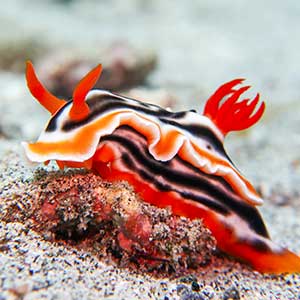
Magnificent Nudibranch (Chromodoris magnifica)
Magnificent Nudibranch is named for is vibrant and striking colors. Chromodoris magnifica is easily confused with the Chromodoris quadricolor.
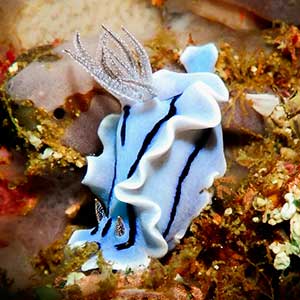
Blue Chromodoris (Chromodoris willani)
Blue Chromodoris is Named for the renowned nudibranch taxonomist Dr. Richard C. Willan
Pale blue with black dark lines and has translucent gills and rhinophores that looks like ice crystals
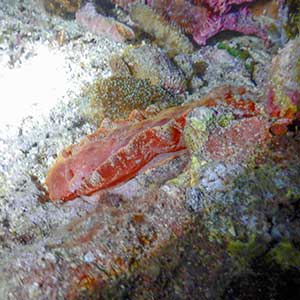
Spanish Dancer (Hexabranchus sanguineus)
Spanish Dancer is named after the way it undulates when it swims in mid-water. It can grow to the size of a loaf of bread.
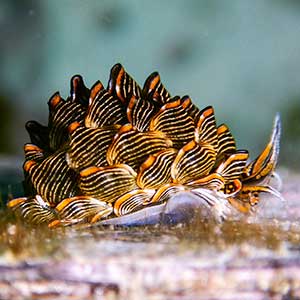
Tiger Butterfly Nudibranch (Cyerce nigra)
Cyerce nigra has black, white and yellow striped cerata. Found in sandy bottom in Romblon.
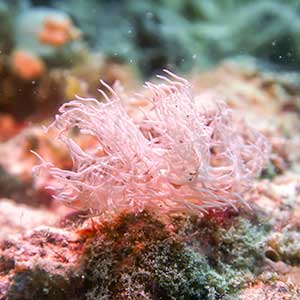
Ghost Nudibranch (Melibe colemani)
Ghost Nudibranch has been dubbed the “Holy Grail of Nudibranchs” can be found in Romblon and Anilao.
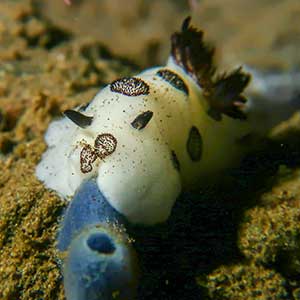
Dotted Nudibranch (Jorunna funebris)
Dotted Nudibranch is sometimes called Oreo Nudibranch. It likes to eat blue sponges.
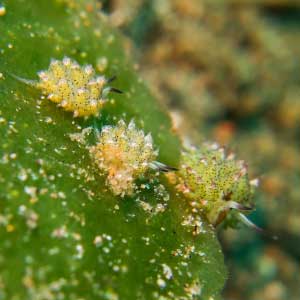
Shaun the Sheep Nudibranch (Costasiella kuroshimae)
Costasiella kuroshimae is a sap-sucking sea slug that looks like sheeps. It is found in sandy bottoms grazing on algae.
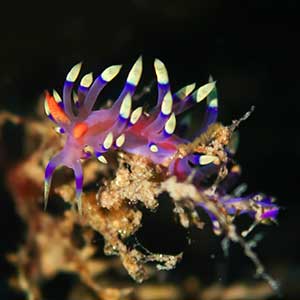
Desirable Flabellina (Coryphellina exoptata)
Coryphellina exoptataiis formerly known as Flabellina exoptata. It loves eating hydroids so you might find them there.
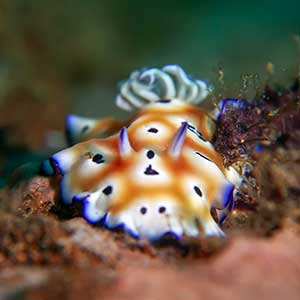
Leopard Nudibranch (Goniobranchus leopardus)
Goniobranchus leopardus has leopard-like marks ringed with white on a brownish background. It looks similar to Hypselodoris tryoni, which has a shorter mantle.
Cephalopods (6)
Cephalopods are among the most photographed marine life in the Philippines. Here are the favorite cephalopods among divers.
Mimic octopus (Thaumoctopus mimicus)
The mimic octopus is one of the most amazing marine life you can find in the Philippines. Thaumoctopus mimicus is able to hunt in broad day light because of it’s ability to change its form to look like other species. The mimic octopus has been known to copy at least 15 different species, like jellyfish, sea snakes, stingrays, crabs, lionfish, and many more.
Wunderpus (Wunderpus photogenicus)
Often confused with or misidentified as a Mimic Octopus, the Wonderpus is a separate species. The wunderpus also has the ability to change patterns and impersonate other species like the mimic octopus. But the Wunderpus photogenicus has a distinct white and reddish-brown coloration and hunts only at night.
Blue Ringed Octopus (Hapalochlaena lunulata)
The blue-ringed octopus is one of the “small but terrible” marine life in the Philippines. They might look pretty but they are actually deadly. They are yellow brown in coloration but when provoked blue rings appear on its body to warn predators of its danger. The Hapalochlaena lunulata have toxins that is lethal to humans and there is no known antidote for it.
Starry Night Octopus (Callistoctopus luteus)
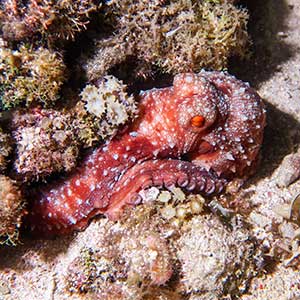
The starry night octopus as its name suggest is active only at night. It has a reddish brown coloration with white speckles that look like stars. They are often found hunting on sandy and rocky reefs.
Bobtail squid (Euprymna berryi)
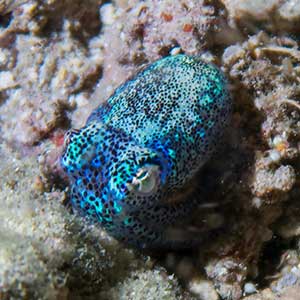
The bobtail squid is a small-sized cuttlefish with dark electric blue and green coloration. They are often found in sandy substrates where they usually hide during the day and hunt in at night. The bobtail squid can quickly burrow itself in the sand when it senses danger.
Flamboyant Cuttlefish (Metasepia pfefferi)
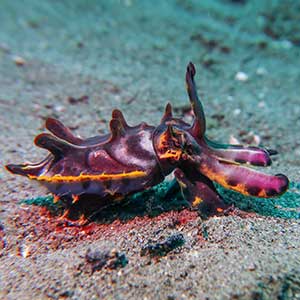
Flamboyant Cuttlefish is a 6-8 centimeters cephalopod often found in sandy or mucky substrates. Their distinct coloration also makes them a popular marine life in the Philippines. They are the only cuttlefish that has muscle tissue that is highly toxic.
Crabs (5)
Crabs are favorite marine critters in the Philippines as well.
Porcelain Crab (Neopetrolisthes maculatus)
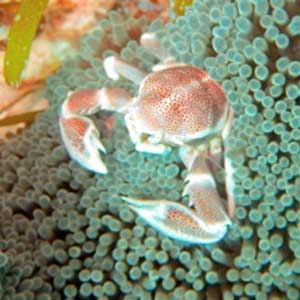
Porcelain Crabs, have a whitish shell with red dots. Also known as Porcelain Anemone Crabs, they have a commensal relationship with anemones species. Neopetrolisthes maculatus have three walking legs and pincers often used for protection rather than feeding. They are filterfeeders so they have mouths that fans out to catch planktons.
Orangutan Crab (Achaeus japonicus)
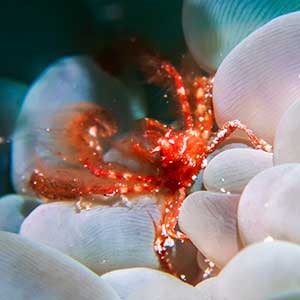
The Achaeus japonicus commonly known as orangutan crabs are decorator crabs that cover themselves with brown and red debris. These hairy covering makes them look like orangutans. They are found in Bubble corals (Plerogyra sinuosa) or Torch corals (Euphyllia glabrescens)
Boxer Crab (Lybia tesselata)
The boxer crabs, also known as pom-pom crabs, are known for their mutualism relationship with anemones. Instead of living in the anemone they actually hold the anemones in their claws for defense, and in return the anemones get carried around to capture more food. These crabs are tiny at 2.5 cm (1 inch) width so they do look like mini cheerleaders.
Candy Crab (Hoplophrys oatesi)
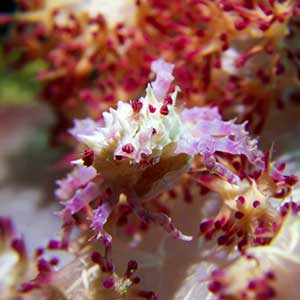
The candy crab lives exclusively in Dendronephthya soft corals. They get its name from the purple, pink, red, yellow or white candy-like coloration. They’re 2 cm small and their thorny/pointy shell makes them look like the polyps in the soft corals they live in.
Hairy Squat Lobster (Lauriea siagiani)
The hairy squat lobster, also known as Barrel-sponge Crab, Fairy Crab, Fairy Lobster, are pink hairy crabs found on the external parts of giant barrel sponges- Xestospongia testudinaria.
Shrimps (9)
Here are some of the most photographed shrimps in the Philippines.
Ambon Crinoid Shrimp (Laomenes amboinensis)
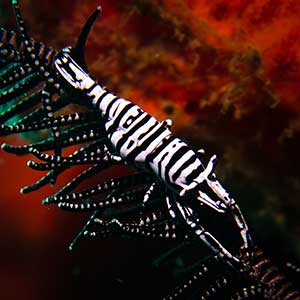
The Ambon Crinoid Shrimp or Feather Star Shrimp are shrimps that can grow up to 2 cm in size. Periclimenes amboinensis lives in crinoids and hides among the arms of its host. They may come in various colors depending ton the colors of the crinoid.
Harlequin Shrimp (Hymenocera elegans)
The harlequin shrimp is among the most sought after photography subjects among divers because of its vibrant exo-skeleton. Hymenocera elegans are white to a light pink in color and covered with graduated spots of blue, purple, red, and orange colors. Aside from its appearance what’s also fascinating is the harlequin shrimp’s ability to devour entire star fishes. They keep the sea star captive until they are consumed and the process may take up to two weeks.
Sexy Shrimp (Thor amboinensis)
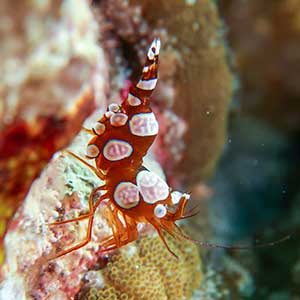
Sexy shrimps are named as such because of their distinct characteristic of curving their abdomens and lifting their bums tails up over their heads. Thor amboinensis are tiny orange shirmps with white spots. You may find them in anemones but you need to go close to see them as they are only 13mm (0.5 inches) in size.
Emperor Shrimp (Periclimenes imperator)
The emperor shrimp is a favorite marine life in the Philippines especially for underwater photographers. This 2 cm crustacean loves piggybacking on a variety of hosts like sea cucumbers and nudibranchs. They come in the majestic colors of orange, white and royal purple.
Coleman’s Shrimp (Periclimenes colemani)
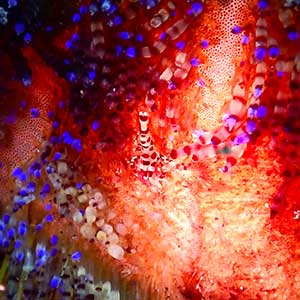
Coleman’s Shrimp, also known as Fire Urchin Shrimp, Sea Urchin Shrimp are usually found in pairs perched on a fire urchin (Asthenosoma sp.)
Dragon Shrimp (Miropandalus hardingi)
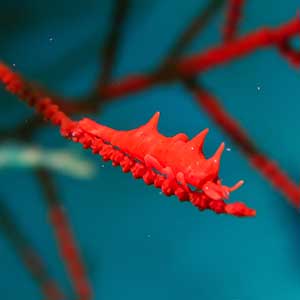
The dragon shrimp, also known as gorgonian sandaled shrimp, is found in branches of gorgonians or whip corals. They grow up to 3 cm. But you need to look closely as their coloration usually matches their host’s color- from green, yellow, brown, or red. The dragonesque form also mimics the corals pointy tentacles making it harder to spot them.
Hairy Shrimp (Phycocaris simulans)
The hairy shrimp is one of the most challenging crustaceans to find as they are tiny and look like a piece of algae. They grow up to 5mm only. They are sometimes white, brown, red, yellow or green. Their coloration and “hairy” look make it easier for them to blend in between rocks and rubbles.
Skeleton Shrimp (Caprella sp.)
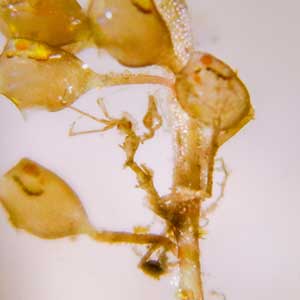
Skeleton shrimps are not really shrimps but are classified as amphipods. They have long, stick-like bodies that are usually transparent. Skeleton Shrimps look like aliens or praying mantis. And similarly to praying mantis that kill their mates after mating, some female skeleton shrimp may kill the male after mating by injecting them with venom from a poisonous claw. You can find skeleton shrimps in hydroids and sponges.
Peacock Mantis Shrimp (Odontodactylus scyllarus)
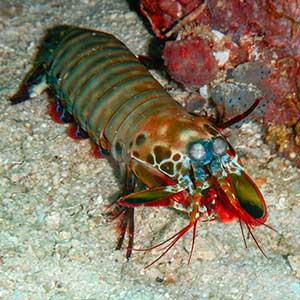
Despite its name, mantis shrimp are not shrimps but are stomatopods- a distant relative of crabs, shrimp, and lobsters. The peacock mantis shrimp are known for their bright red, green, and blue exoskeletons making them a favorite subject for underwater photographers. They are also known for the fast-punching movements they use for hunting. Their strikes are so powerful that photographers are warned to keep their distance as peacock mantis shrimps have been known to break through an aquarium’s glass wall.
Marine Worms (5)
Persian Carpet Flatworm (Pseudobiceros bedfordi)
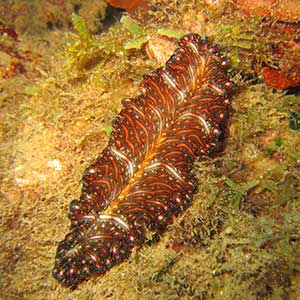
Persian Carpet Flatworm is 8–10 cm in length with a distinctive pattern. Its coloration is black with pink lines and bright yellow spots.
Bobbit Worm (Eunice aphroditois)
The bobbit worm is a predatory polychaete worm dwelling in the ocean’s soft sandy substrate. They vary in size but the longest bobbit worm ever recorded was found to be 3 meters (9.8 ft) long! Its hard shell has holographic/metalic colors which makes them standout. But what makes these creatures even more outstanding is their ability to hide on the ground and wait for prey to stimulate their 5 antennae. Once they detect potential food, they attack with teeth so sharp it can slice their prey into two.
Golden Fireworm (Chloeia flava)
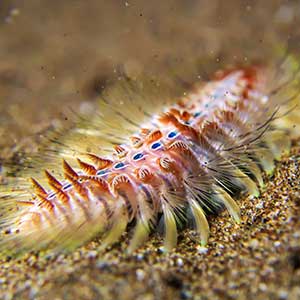
The golden fireworms are flat and broad worms with lots of hairy bristles on its side. They grow to about 10cm long and found on sandy substrates, usually at night. The bristles of Chloeia flava are filled with toxins so refrain from petting these critters. If the bristles penetrate your bare skin, it will cause you intense itching, inflamation and numbness.
Christmas Tree Worm (Spirobranchus sp.)
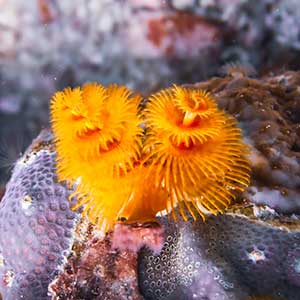
The bright tree-like spiral you see are actually the feeding and respiratory parts of a worm. The Christmas Tree Worm secretes a tube around its body and this serves as it’s home and protection while it embeds itself in a massive hard coral. When you find a porites or brain coral with holes in it, there could be a Spirobranchus species living in it.
Feather Duster Worm (Bispira sp.)
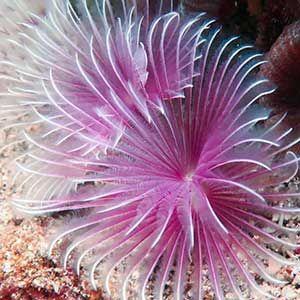
Feather duster worms are a family of marine worms characterized by protruding feathery gills. These worms build tubes out of mucus, sand and bits of shell to serve as its home. The feather duster worm has tentacles they use to capture food. When it senses danger, the worm retracts back into its tube.
Corals in the Philippines (5)
Here are some of the endemic corals in the Philippines.
Bubble Corals (Plerogyra sinuosa)
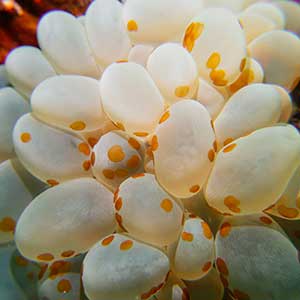
The bubble corals also known as grape coral or s are grape-sized which increase their surface area according to the amount of light available: they are larger during the day, but smaller during the night, when tentacles reach out to capture food.
Orange Cup Corals (Tubastrea coccinea)
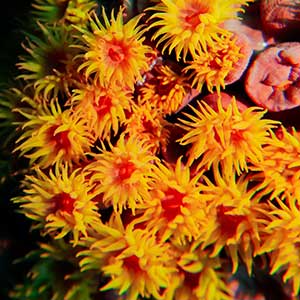
Tubastraea coccinea, commonly known as orange cup corals or sun corals, are large-polyp stony corals. When the corals are feeding, small clusters of bright yellow or orange polyps appear from its salmon-colored (pinkish-orange) cups. Unlike other corals that may need sunlight to live, ironically, these sun corals can grow in darkness as long as it can capture zooplanktons, their food.
Mushroom Corals (Fungia sp.)
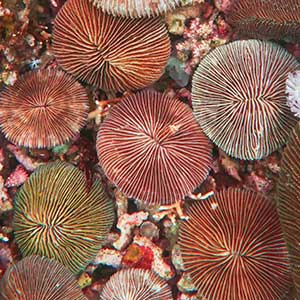
Mushrooms corals are hard corals that consists of a single organism with multiple mouths. Fungia sp can grow up to 30 centimeters in diameter in various colors of white, pink, red purple, blue and yellow. The discs are either round or oval and the central mouth. Tentacles can be found in between the grooves of the discs. These are very popular among artificial reef enthusiasts.
Brain Corals (Platygyra sp.)
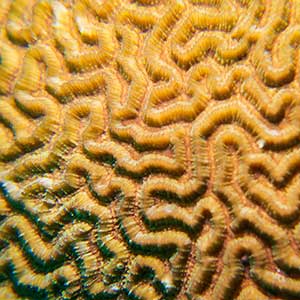
This reef-building, hard coral gets its name from how closely it resembles a human brain. The brain coral (Platygyra sp.) is sometimes called the maze coral. Their distinct shape and patterns makes them a favorite in the aquarium trade as well.
Daisy Corals (Goniopora sp.)
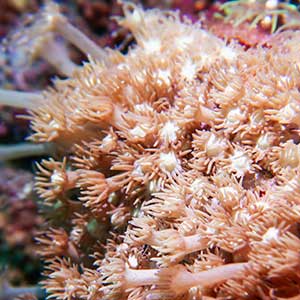
Daisy Coral, also known as Flowerpot Coral, Sunflower Coral, and Ball Coral, get its name from its flower-like appearance. Their distinctive features are the elongated polyps topped with a fringe of tentacles surrounding a mouth area. The goniopora species extend their polyps during the day and retract at night. Interestingly, if you disturb one part of the coral, the rest of the coral polyps will also retract as if to protect itself.
If you love seeing creatures and learning about them? Do check out this list of 15 PADI Distinctive Specialty Courses for Marine Life Lovers.
Pin this for later! Or share this article to a friend and encourage them to protect these wonderful sea creatures in the Philippines!
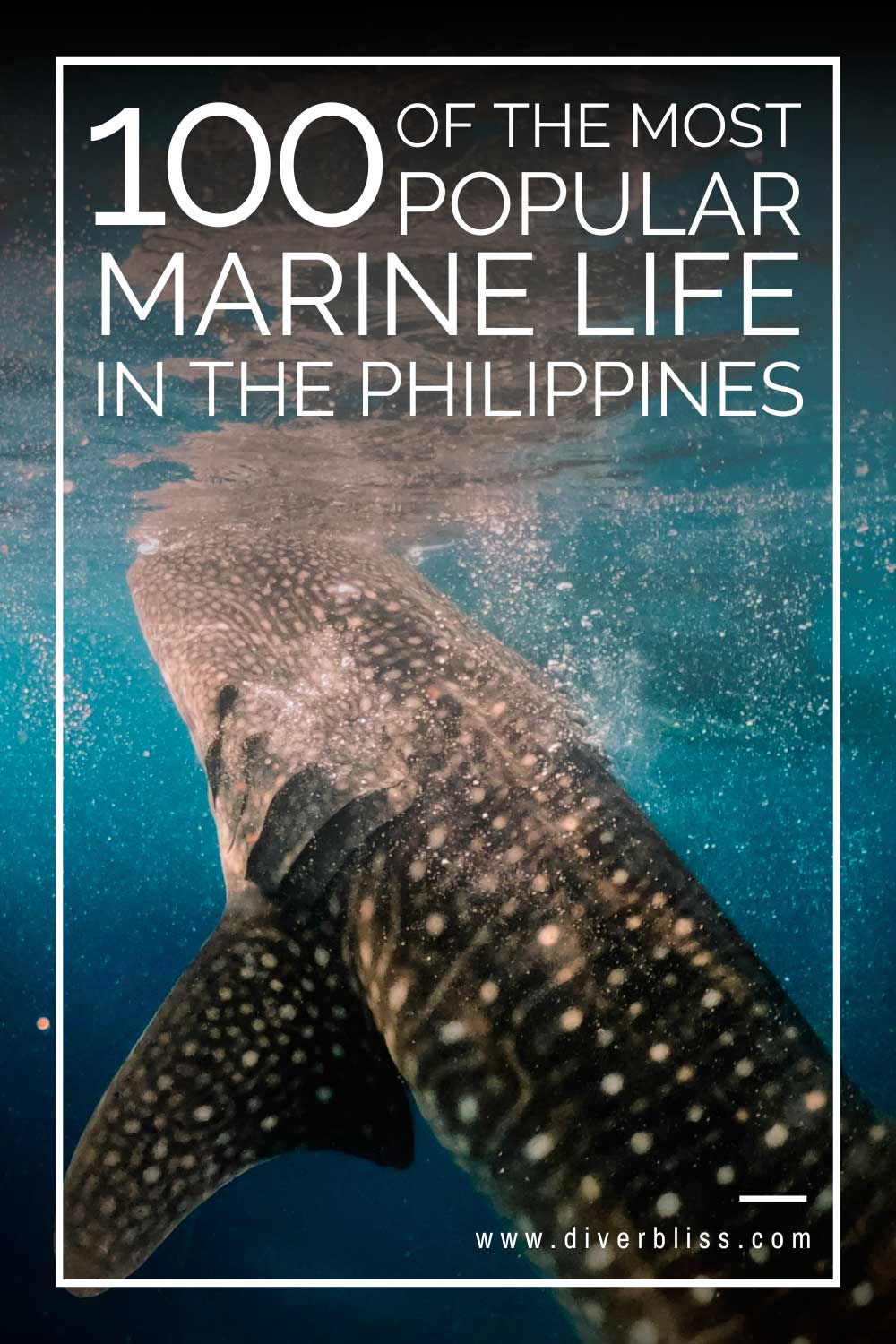
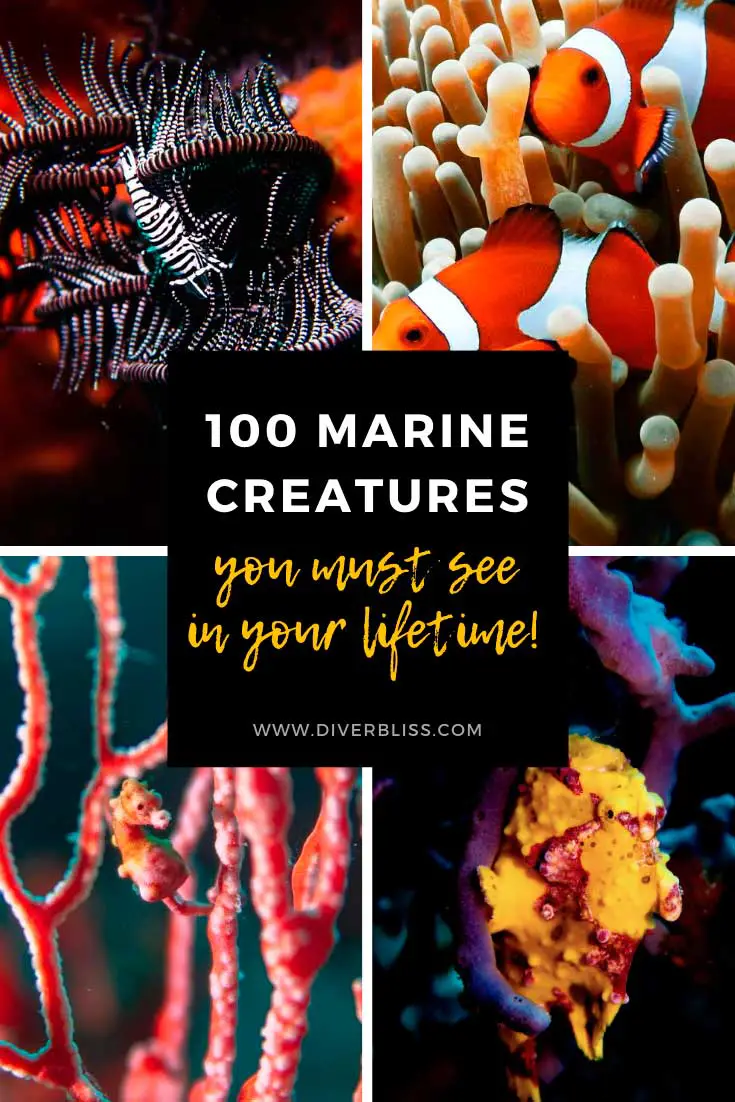
Did you enjoy this list of marine life in the Philippines? Which ones are you looking forward to seeing? Which one should I add to the most popular marine life in the Philippines? Leave a comment below!
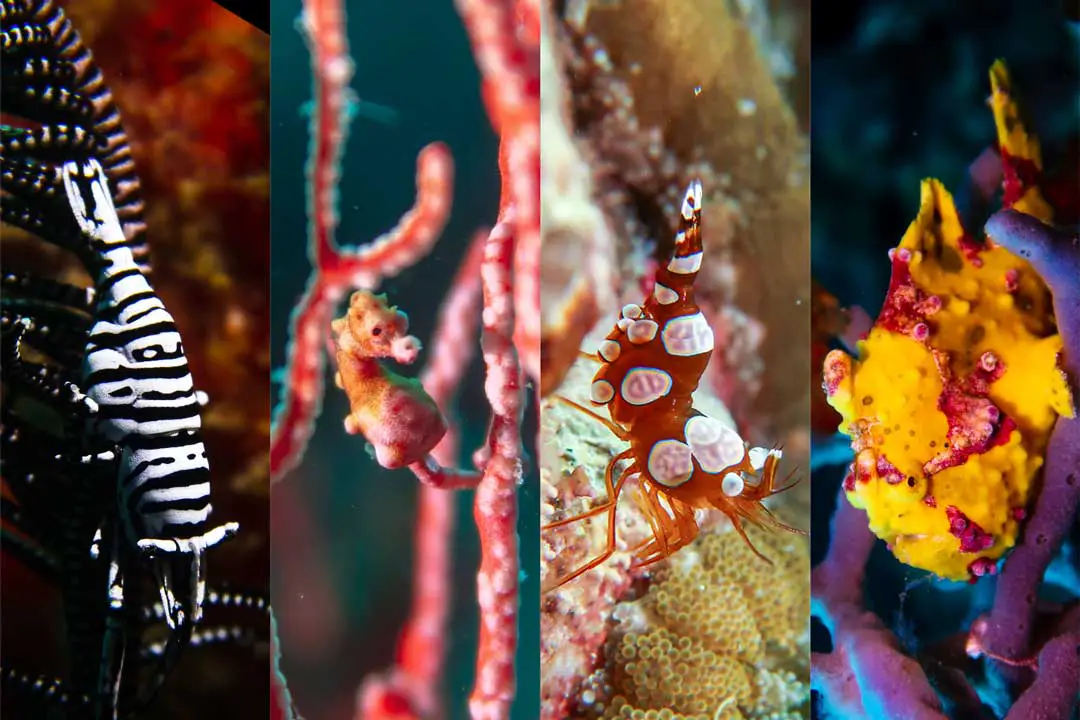
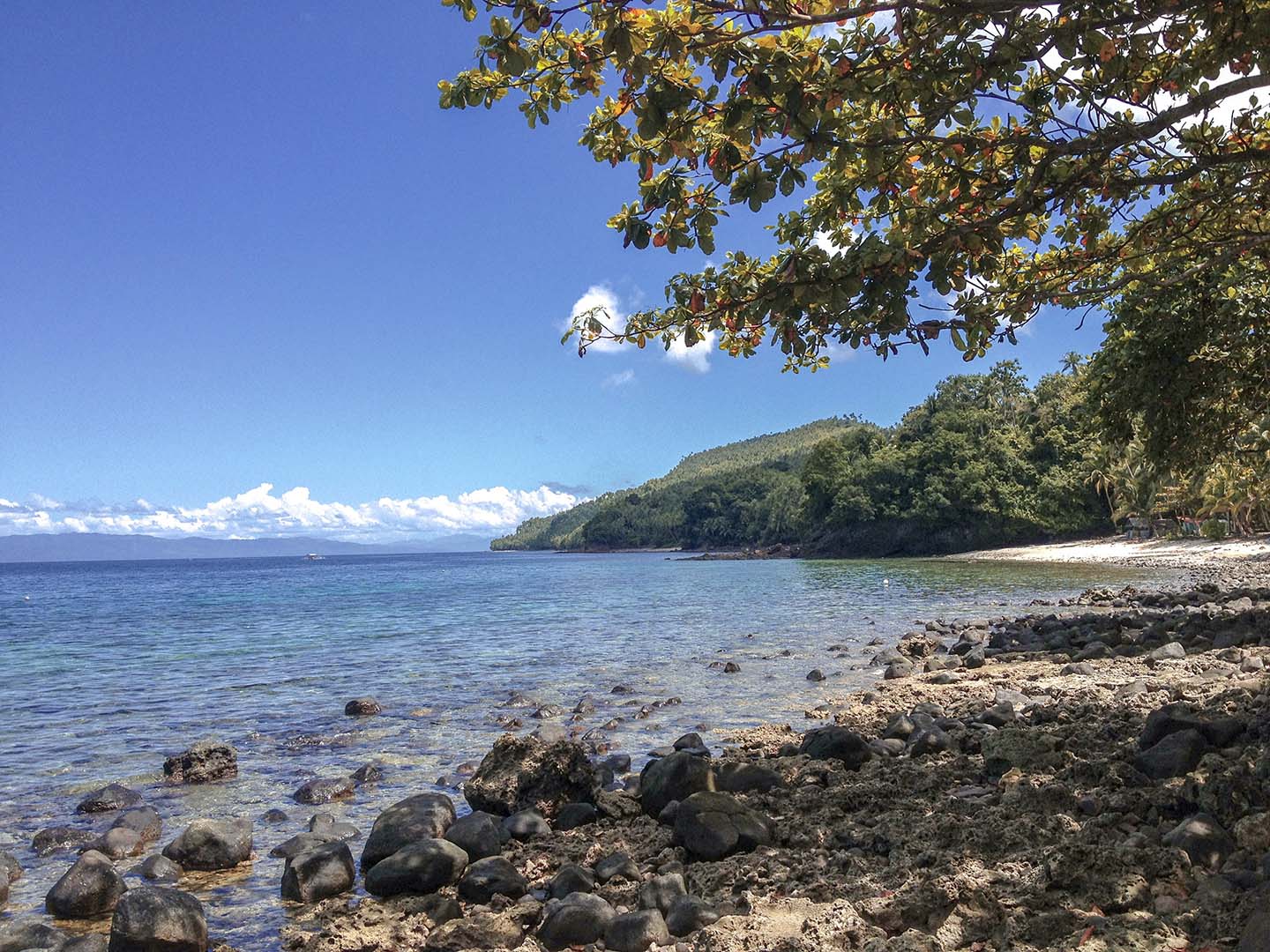
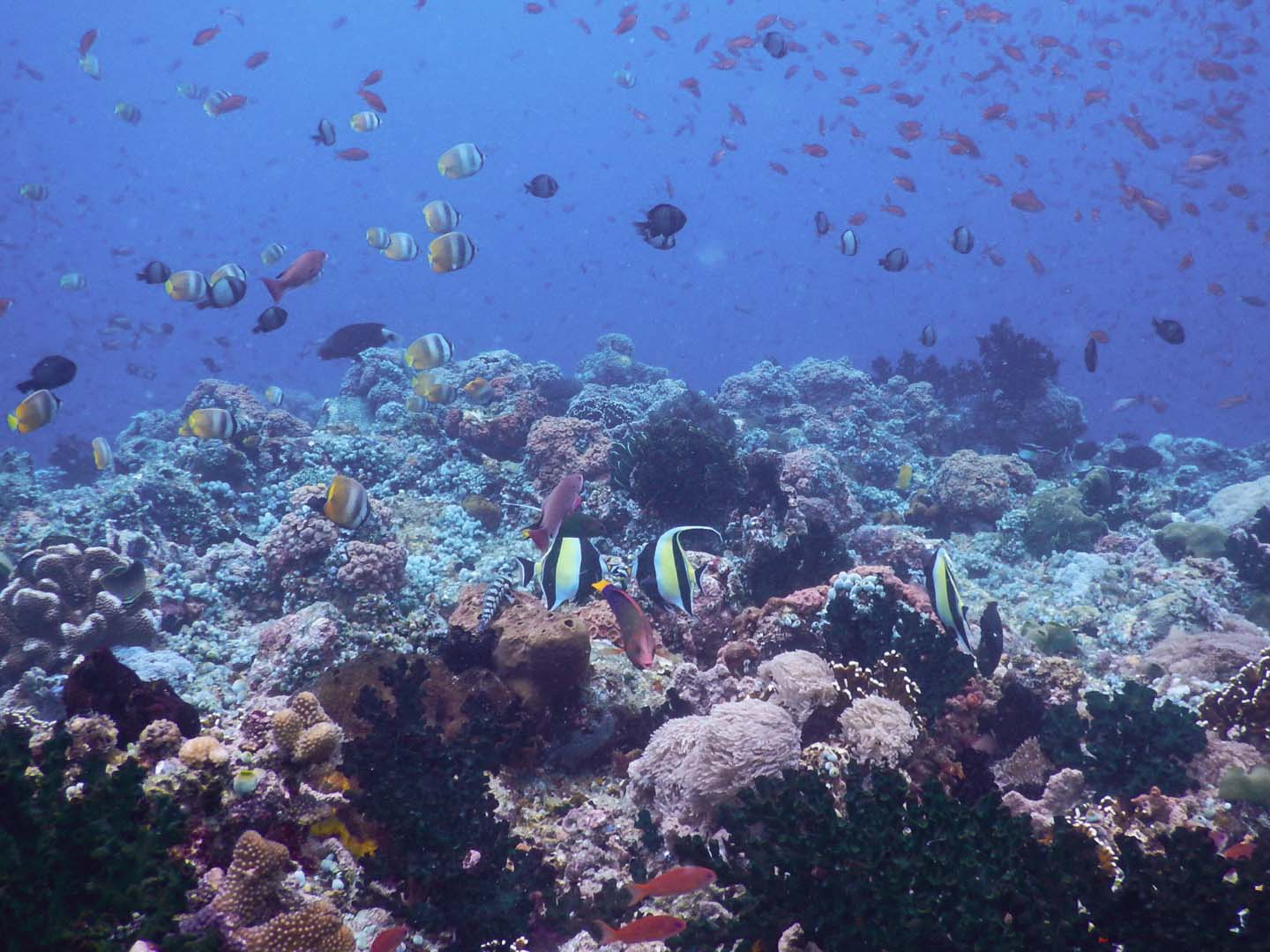
another awesome post Ara 🙂
Thanks, Camille! 🙂